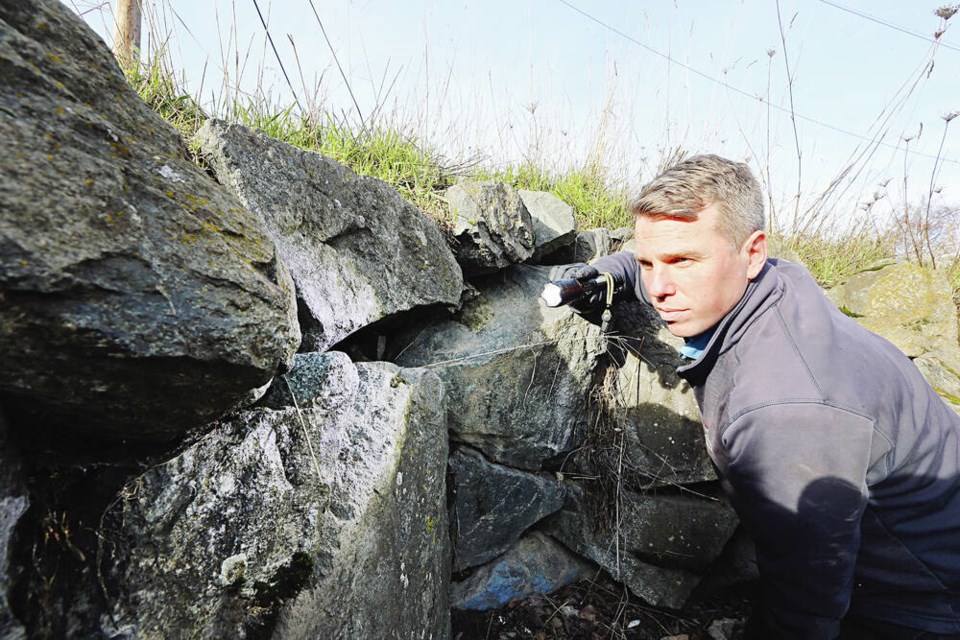A year after a provincial ban on a poisonous bait used to control rodents, pest-control businesses are busier than ever trying to keep the rat and mouse population under control.
Last January, the province strictly limited the sale and use of second-generation anticoagulant rodenticides, which typically require just one feeding to kill the intended target.
The problem was that the poison does not break down quickly — a process called bioaccumulation — and predators such as owls that feed on the carcasses can themselves get sick and sometimes die.
To protect wildlife, bait containing Brodifacoum, Bromadiolone or Difethialone was taken off the shelves in B.C.
But Kurtis Brown, an associate certified entomologist with Victoria Pest Control, says any increase in the rat population is less about lack of poison than the abundance of food. “Having access to food just allows rats to have more litters.”
A popular recent video from Vancouver showed dozens of rats around a park in front of the Burrard Skytrain station, scurrying under the feet of commuters.
While some pest-control experts in Vancouver blamed the rodenticide ban for the rat proliferation, Brown pointed out the rats in the video could be seen feeding on birdseed scattered on the ground, likely from someone feeding pigeons earlier in the day.
“It was just a lot easier to poison them than to clean up the garbage the rats feed on,” said Brown, who has been in the industry for 21 years.
He said some of the growth in the rat population comes as homeowners increasingly grow their own food, compost food scraps and keep backyard chickens.
Rats can have up to six litters per year, with the spring and fall litters the largest, due to the abundance of food at those times of the year. Litters can be as large as a dozen, but the average is around eight. Compounding the problem is the fact that rats can reach sexual maturity in as little as six weeks.
Nests consists of family units of between five and 10 rats, with multiple nests making up a colony.
“I once captured 100 rats in 30 days, with a total of 306 at the end of four months in a downtown restaurant,” said Brown, as he surveyed a rocky embankment in the Bay and Douglas area that he estimated contained a colony of more than 50 rats.
He said the two most common types of rats on Vancouver Island are the roof and Norway rat, both of which can breed effectively year-round, thanks to our temperate climate.
The rodenticide ban has meant homeowners have to pay more to eradicate rodents, as trapping rats becomes one of the only ways to cut down on their population.
“Setting down a bait station and traps is a lot more time-intensive, making it more expensive for homeowners experiencing an outbreak,” said Brown, noting most traps are only able to capture one rat at a time.
As for cats, they may catch a rat a day, but it’s generally just the youngest and the oldest members of the colony.
Cats also need to be fed, which can inadvertently add to a rat problem.
Brown recalls one time the company was hired to catch a rat in a house and eventually found its nest hidden behind the clothes dryer — about five feet from the cat-food bowl.
After not finding any openings in the exterior of the house, they suspect it was the cat that brought the rat into the house, where it eventually escaped.
Brown said rats have grown so accustomed to eating cat food that pest-control experts routinely bait rat traps with it.
Kaylee Byers, a senior scientist with the Pacific Institute on Pathogens, Pandemics and Society at Simon Fraser University, said the lack of a comprehensive system for rat sightings makes it hard for wildlife biologists to tell if populations are growing.
“The thing is, nobody actually knows and that’s because we don’t have any form of municipal systematic reporting system for rats and rat sightings in the city,” said Byers, who joined the Vancouver Rat Project, an attempt to monitor and study rat movements around the city, in 2013.
“The best thing we have is sort of anecdotal evidence, which is calls to pest-control professionals, but that data is not perfect because not everybody will call a pest-control professional.”
Homeowners can take steps to mitigate a rat problem, including eliminating or minimizing the rat’s access to food, water and habitat in their neighbourhood, and making their properties less inviting for rodents to hang around or live in.
That can include ripping out dense ground coverings close to homes, as the vegetation provides aerial cover against predators and hides the entrances to burrows.
They can also trap raps and administer first-generation anticoagulant rodenticides, which require multiple feedings.
“Rats are a part of our cities, and managing them is a complex issue,” said Byers. “Part of the problem is that we’re approaching it like it’s a simple one. See a rat, remove a rat, or kill a rat and it’s not working.
“We need to think more broadly, we need to address it as a complex issue in order to come up with innovative and multiple solutions to managing rats now and in the future.”
— With files from The Canadian Press



